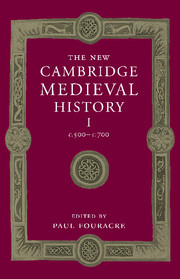Book contents
- Frontmatter
- Introduction: the history of Europe 500–700
- 1 The later Roman Empire
- 2 The Barbarian invasions
- 3 The sources and their interpretation
- PART I THE SIXTH CENTURY
- PART II THE SEVENTH CENTURY
- PART III THEMES AND PROBLEMS
- 20 The Jews in Europe 500–1050
- 21 Kings and kingship
- 22 The Mediterranean economy
- 23 The Northern Seas (fifth to eighth centuries)
- 24 Money and coinage
- 25 Church structure and organisation
- 26 Christianisation and the dissemination of Christian teaching
- 27 Education and learning
- 28A Art and architecture of western Europe
- 28B Art and architecture: the East
- List of Primary sources
- Bibliography of secondary works arranged by chapter
- Index
- Frontispiece"
- Plate section"
- Map 3 Gaul/Francia in the sixth and seventh centuries"
- References
23 - The Northern Seas (fifth to eighth centuries)
from PART III - THEMES AND PROBLEMS
Published online by Cambridge University Press: 28 March 2008
- Frontmatter
- Introduction: the history of Europe 500–700
- 1 The later Roman Empire
- 2 The Barbarian invasions
- 3 The sources and their interpretation
- PART I THE SIXTH CENTURY
- PART II THE SEVENTH CENTURY
- PART III THEMES AND PROBLEMS
- 20 The Jews in Europe 500–1050
- 21 Kings and kingship
- 22 The Mediterranean economy
- 23 The Northern Seas (fifth to eighth centuries)
- 24 Money and coinage
- 25 Church structure and organisation
- 26 Christianisation and the dissemination of Christian teaching
- 27 Education and learning
- 28A Art and architecture of western Europe
- 28B Art and architecture: the East
- List of Primary sources
- Bibliography of secondary works arranged by chapter
- Index
- Frontispiece"
- Plate section"
- Map 3 Gaul/Francia in the sixth and seventh centuries"
- References
Summary
It is a well-known fact these days that the seas of northern Europe – from the Atlantic to the Baltic, by way of the Channel and the North Sea – are amongst the busiest and most used in the world. But at what point did they begin to play a significant role in Europe’s system of communications and trade? Despite the numerous claims handed down to us by Pytheas, Caesar, Strabo, Pliny, Tacitus, Ptolemy and others in their travel memoirs or in their geographies, it is clear that, in ancient times, northern Europe was a distant horizon. It was almost the furthermost, just like certain of its inhabitants, such as the Morins of the Pas-de-Calais, whom Virgil described as extremi hominum. At that time, the Mediterranean was the chief axis for trade and exchanges, not only between East and West, but also between South and North. The Northern Seas were then simply a distant destination in a communications system in which – to take a single example – traffic between oman Britain and the continent was justified chiefly by the military requirements of the Empire and by its need for supplies of metal. It is clear from studying written sources and archaeological and numismatic artefacts that it was during the early Middle Ages that the Northern Seas started to play an essential role in the communications system and economy of the Western world.
Keywords
- Type
- Chapter
- Information
- The New Cambridge Medieval History , pp. 639 - 659Publisher: Cambridge University PressPrint publication year: 2005
References
- 1
- Cited by



